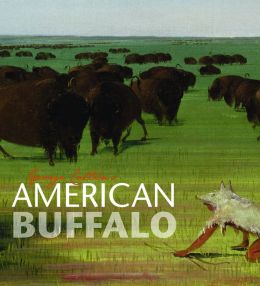Jackson Hole summer visitors can enjoy a new George Catlin art exhibition focusing on the painter’s 1800s chronicling of Native Americans and bison, opening on May 18. Organized by the Smithsonian American Art Museum in collaboration with the National Museum of Wildlife Art, the show features 40 original Catlin paintings.
George Catlin, "Buffalo Bull, Grazing on the Prairie," 1832-1833, oil on canvas, Smithsonian American Art Museum, Gift of Mrs. Joseph Harrison, Jr.
“Catlin's paintings illuminate in great detail the close ties between Native American tribes and bison in the 1830,” says Adam Duncan Harris, curator of art for the National Museum of Wildlife Art.
http://www.prweb.com/releases/2013/4/prweb10622526.htm
Jackson Hole travelers can supplement always popular bison viewing in Yellowstone National Park this summer with a rare chance to see what the herds looked like in the early 19th century thanks to a special May – August exhibition opening at the National Museum of Wildlife Art. Taking a fresh look at the famous works of 19th-century painter George Catlin through the lens of his representation of buffalo and their integration into the lives of Native Americans, the new exhibition, "George Catlin’s American Buffalo," will debut at the museum in Jackson Hole, Wyo., on May 10, 2013.
"George Catlin’s American Buffalo" features 40 paintings by the artist, who produced some 500 works based on travels among 50 Native American tribes in the 1830s. The exhibition, organized by the Smithsonian American Art Museum in collaboration with the National Museum of Wildlife Art, is drawn entirely from the Smithsonian American Art Museum’s collection. "George Catlin’s American Buffalo" will be on display in Jackson Hole through August 25, 2013, before traveling to additional museums across the U.S.
George Catlin, "Buffalo Chase with Bows and Lances," 1832-1833, oil on canvas, Smithsonian American Art Museum, Gift of Mrs. Joseph Harrison, Jr.
George Catlin, "Hee-láh-dee, Pure Fountain, Wife of The Smoke," 1832 oil on canvas, Smithsonian American Art Museum, Gift of Mrs. Joseph Harrison, Jr.
“Catlin's paintings illuminate in great detail the close ties between Native American tribes and bison in the 1830s, and his writings about the land and its native inhabitants have informed generations of conservationists as they wrestle with sustainable ways to manage America's Great Plains,” says Adam Duncan Harris, curator of art for the National Museum of Wildlife Art. Harris serves as guest curator of the "George Catlin’s American Buffalo" exhibition and contributed an essay for the show’s

illustrated catalogue, published by the Smithsonian American Art Museum.
“Having the chance to work with the Smithsonian American Art Museum to interpret Catlin's words and images was a great honor,” Harris says. “The resulting exhibit and catalog will help contemporary audiences see Catlin in a new light."
Under the mentorship of Gen. William Clark of the historic Lewis and Clark expedition, George Catlin, a lawyer turned artist, undertook a quest to record the life and culture of American Indians living on the Plains. The project took him on an epic journey that stretched more than 2,000 miles along the upper Missouri River and made him one of the earliest artists of European descent to chronicle the massive herds of buffalo roaming America’s Great Plains. Along the way, Catlin captured how embedded the buffalo was in Native Americans’ lives, from food and shelter to ceremony and naming.
The new exhibition also explores Catlin’s role as an early proponent of wilderness conservation. A prolific writer, Catlin wrote in the 1830s that without some greater measure of restraint on the part of advancing settlers, the buffalo would soon be eradicated from the plains. He called for the establishment of a “nation’s Park” set aside from development as a refuge for buffalo and native tribes, a vision that partially came true with the establishment of Yellowstone National Park in 1872.
"George Catlin’s American Buffalo" is organized by the Smithsonian American Art Museum in collaboration with the National Museum of Wildlife Art in Jackson Hole, Wyoming.
George Catlin was among the earliest artists of European descent to travel beyond the Mississippi River to record what he called the “manners and customs” of American Indians, painting scenes and portraits from life. His intention was to document these native cultures before, as he feared, they were irrevocably altered by settlement of the frontier and the mass migrations forced by the Indian Removal Act of 1830. On his trips, Catlin recorded the massive herds of buffalo that roamed the Great Plains of the American West. In chronicling the lifeways of Plains Indian cultures, he captured the central importance of the buffalo in the daily lives of American Indian tribes, from food and shelter to ceremony and naming.
Confirmed venues include:
National Museum of Wildlife Art in Jackson Hole, Wyoming (May 10, 2013–August 25, 2013)
Palm Springs Art Museum in Palm Springs, California (October 1, 2013–December 29, 2013)
C.M. Russell Museum in Great Falls, Montana (May 31, 2014–Sept. 14, 2014)
Mennello Museum of American Art in Orlando, Florida (October 4, 2014–January 1, 2015)
Reynolda House Museum of American Art in Winston Salem, North Carolina (February 12, 2015–May 3, 2015)